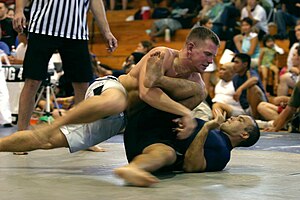Grappling: Difference between revisions
m Reverted 1 edit by Willyboybjj; Rm linkspam. (TW) |
Willyboybjj (talk | contribs) |
||
| Line 80: | Line 80: | ||
* [http://www.kobukaijujitsu.com/grapplingstyles.html World grappling styles] |
* [http://www.kobukaijujitsu.com/grapplingstyles.html World grappling styles] |
||
*[http://www.globalsecurity.org/military/library/policy/army/fm/3-25-150/ch3.htm/ Modern Army Combatives basic grappling][http://www.globalsecurity.org/military/library/policy/army/fm/3-25-150/ch3.htm/ M.A.C. cont'd, advanced grappling] |
*[http://www.globalsecurity.org/military/library/policy/army/fm/3-25-150/ch3.htm/ Modern Army Combatives basic grappling][http://www.globalsecurity.org/military/library/policy/army/fm/3-25-150/ch3.htm/ M.A.C. cont'd, advanced grappling] |
||
*[http://willyboybjj.blogspot.com/ Willyboy´s blog] BJJ,Grappling,MMA techniques blog |
|||
[[Category:Combat sports]] |
[[Category:Combat sports]] |
||
[[Category:Martial art techniques]] |
[[Category:Martial art techniques]] |
||
Revision as of 19:17, 11 April 2008
This article needs additional citations for verification. (July 2007) |

Grappling refers to the gripping, handling and controlling of an opponent without the use of striking, typically through the application of various grappling holds, choke holds, and counters to various hold attempts. Grappling forms an important part of both ground fighting and standing clinch fighting. Sports that use grappling include Brazilian jiu-jitsu, Judo, mixed martial arts and Wrestling. FILA uses the term grappling interchangeably with the sport of submission wrestling.[1]
Grappling is a mode of fighting used by many different martial arts around the world. It is not a distinct martial art, but rather, similarly to striking, a collection of techniques and strategies aimed at defeating an opponent, these can be subdivided into:
- Throws (as used in Glima, Judo, Jujutsu, Shuai jiao and Sambo).
- Joint locks (as in Aikido, Brazilian Jiu Jitsu, Hapkido, Judo, and Malla-yuddha).
- Pinning Techniques; a victory condition in Wrestling and Judo and as as transitional technique in others.
Most include all of the above aspects while others focus on one. There is no definite dividing line between the sections as locks may be used in throws and a throw may lead directly to a pin. A possible fourth category are sweeps and escapes, used to improve position in ground fighting either escaping from or moving into a position where a lock or pin may be better applied.
Use
The degree to which grappling is utilized in different fighting systems varies. Some systems, such as Amateur wrestling, Submission wrestling, Judo and Brazilian Jiu-Jitsu are exclusively grappling arts, and do not allow striking. Many combat sports such as Shooto and mixed martial arts competitions emphasize grappling while retaining striking as part of the sport.[2]

Grappling is not allowed in all martial arts and combat sports; usually for the sake of focusing on other aspects of combat such as punching, kicking or Mêlée weapons. Opponents in these types of matches, however, still grapple each other occasionally when fatigued or in pain; when this occurs, the referee will step in and restart the match, sometimes giving a warning to one or both of the fighters. Examples of these include Boxing, Kickboxing, Taekwondo, Karate, and fencing. While prolonged grappling in Muay Thai will result in a separation of the competitors, the art extensively uses the clinch hold known as a double collar tie.
Grappling techniques and defenses to grappling techniques are also considered important in self-defense applications and in law enforcement. The most common grappling techniques for self defense taught are escapes from holds and application of pain compliance techniques.
Grappling can be trained for self defense, sport and mixed martial arts (MMA) competition.
Stand-up grappling
Stand-up grappling or sometimes clinching, (in judo called tachi-waza, 立技"standing technique") is arguably an integral part of all grappling and clinch fighting arts, considering that two combatants generally start fighting from a stand-up position. The aim of stand-up grappling varies according to the martial arts or combat sports in question. Its nature can be defensive such as in Aikido or offensive such as in Judo or Wrestling. Defensive stand-up grappling concerns itself with pain-compliance holds and escapes from possible grappling holds applied by an opponent, while offensive grappling techniques include submission holds, takedowns and throws, all of which can be used to inflict serious damage, or to move the fight to the ground. Stand-up grappling can also be used both offensively and defensively in combination with striking, either to prevent the opponent form obtaining sufficient distance to strike effectively, or to bring the opponent close to apply, for instance, knee strikes such as in Muay Thai.
In combat sports, stand-up grappling usually revolves around successful takedowns and throws. In Judo a fight is over if one of the judoka score an ippon, and in some sports such as Glima, the fight is over once one of the opponents has fallen down.

Ground grappling
Ground grappling (called ne-waza "ground technique" in Judo) refers to all the grappling techniques that are applied while the grapplers are no longer in a standing position. A large feature in most martial arts and combat sports featuring ground grappling is positioning and obtaining a dominant position. A dominant position (usually on top) allows the dominant grappler a variety of options, including: to attempt to escape by standing up, to obtain a pin or hold-down to control and exhaust the opponent, to execute a submission hold, or to strike the opponent. The bottom grappler is on the other hand concerned with escaping the situation and improving his or her positioning, typically by using a sweep or reversal. In disciplines where the guard is used, the bottom grappler may also be able to finish the fight from the bottom by a submission hold.
Applications
When unskilled fighters get embroiled in combat, a common reaction is to grab the opponent in an attempt to slow the situation down by holding them still, resulting in an unsystematic struggle that relies on brute force. A skilled fighter, in contrast, can perform takedowns as a way of progressing to a superior position such as a mount or side control, or using clinch holds and ground positions to set up strikes, chokeholds and joint locks. A grappler who has been taken down to the ground can use defensive positions such as the guard, which protects against being mounted or attacked. If a grappler is strong and can utilize leverage well, a takedown itself can be a form of attack -- the impact to the head can render some opponents unconscious. On the other hand, grappling also offers the possibility of controlling an opponent without injuring them. For this reason, most police staff receive some training in grappling. Likewise, grappling sports such as judo have been devised so that their participants can compete using full physical effort without injuring their opponents.
It should be noted, however, that heavier fighters - those with limited mobility, that is - use grappling to either pull their opponent close enough for a powerful hit or throw their opponent with enough force to temporarily cripple them.
Grappling is called dumog in Eskrima. The term chin na in Chinese martial arts deals with the use of grappling to achieve submission or incapacitation of the opponent (these may involve the use of acupressure points). Some Chinese martial arts, Aikido and some Eskrima systems - as well as medieval and Renaissance European martial arts - practice grappling while one or both participants is armed. This practice is significantly more dangerous than unarmed grappling, and generally requires a great deal of training.
Types of Grappling
Some of the more well known systems of pure grappling are Brazilian Jiu-Jitsu, Judo, Freestyle wrestling, Russian Sambo and Wrestling. [citation needed]
In these arts, the object is either to take down and pin the opponent, or to catch the adversary in a specialized chokehold or joint-lock which forces him or her to submit and admit defeat. There are two forms of grappling that dictate pace, and style of action: with a gi and without. The gi form is known for its emphasis on grips using the gi, while the "no-gi" form emphasized body control of the torso and head. The use of the gi is compulsory in Judo and some sections of Brazilian Jiu-Jitsu competition.
FILA
As described by FILA Grappling is a wrestling style also called submission wrestling or “submission grappling” which consists of controlling the opponent without using striking, in standing position or on the ground after a throw.[1]
See also
References
- ^ a b International Federation of Associated Wrestling Styles
- ^ Krauss, Erich (1 Dec 2004). Warriors of the Ultimate Fighting Championship. U.S.: Citadel Press Inc.,. ISBN 0806526572.
{{cite book}}: CS1 maint: extra punctuation (link)
- Gracie; Renzo, Gracie, Royler; Peligro, Kid; Danaher, John (2001). Brazilian Jiu-Jitsu: Theory and technique. Invisible Cities Press. ISBN 1-931229-08-2.
- Ohlenkamp, Neil (2006) Judo Unleashed basic reference on judo. ISBN 0071475346.
External links
- BJJ Zone - BJJZone.com
- TheMat.com - National Governing Body
- Grappling Styles
- FILA
- Grappling Arts Association - GAA Organisation for Grappling Arts in the UK
- David Thomas' Grappling Technique Catalog
- Judo grappling techniques Includes images and names of the most common judo ground grappling techniques.
- World grappling styles
- Modern Army Combatives basic grapplingM.A.C. cont'd, advanced grappling
- Willyboy´s blog BJJ,Grappling,MMA techniques blog
